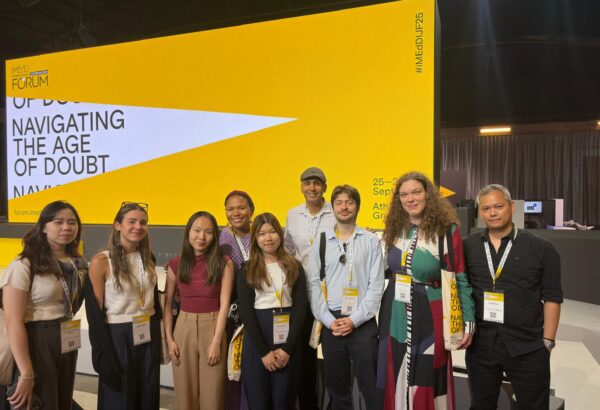Testimony as a Dialogic Practice and Pedagogy: Notes from a Fall 2024 Paideia Course
How can we receive another’s stories – their grief, their pleasure, their bewilderment, their wonder, their rage – in a way that affirms but does not appropriate or presume to understand? How can we share our own stories in a way that allows us to begin to integrate a self that is often required to fragment itself in academic spaces?

These were the questions at the heart of the fall 2024 Comparative Literature course “Testimony: Life-writing as Dialogue.” As an SNF Paideia designated course, it will be unsurprising that “dialogue” was a key concept in the course. But we were thinking about dialogue in an unusual way by doing something that looks on the surface like monologue: writing and sharing personal narratives in public without apparent response from the audience. Dialogue work typically prioritizes what the listener is learning, feeling, or doing in response to hearing someone else’s deeply personal story: the understanding, empathy, or action that comprises the listener’s transformation. I was interested in exploring a dialogue practice that prioritizes what personal sharing does for the sharer, even as the role of the listener remains critical.
What kinds of self-discovery, self-understanding, self-definition, self-affirmation, and individual and collective healing might be activated by the act of personal sharing with a fully receptive, deeply present, but non-reactive listener? Is this kind of “existential listening” even possible to learn and practice?
What was also unusual about the course was that there was no coherent preexisting theory of “testimony” as a dialogue practice that we were studying. The term testimony is used in multiple other fields and contexts. However, though “testimony” seems to always refer in some way to the public sharing of a personal narrative based on lived experience, it means something different and is used towards different ends in each of these contexts: juridical, medical, evangelical, advertising, human rights scholarship and activism (particularly Latin American testimonio), and trauma theory.
Instead of adopting any single one of these other meanings of testimony, we were going to work together to create our own theory(ies) of testimony through our activities in the course. These included 1) exploring the various meanings and effects of testimony in these other contexts and drawing from them what felt right for our purposes; 2) absorbing and analyzing contemporary testimonies in a range of life-writing genres, from poetry to memoir to social media to graphic scholarship to documentary film and more, produced by people of diverse identities and experiences; and 3) writing and sharing publicly our own series of personal narratives.
We were a learning community of eleven (sometimes twelve) people, including myself as the instructor. There were students from all four undergraduate years as well as a sometime Liberal and Professional Studies (LPS) student. Except for me (a Comparative Literature PhD), there was not a single Comp Lit major or minor in this Comp Lit course; our disciplines included Biology; Engineering; Nursing; Political Science; English; Neuroscience; International Relations; French; Philosophy, Politics, and Economics; and more. And, for such a small class, we came from a remarkable range of ethnoracial, religious, and socioeconomic identities, regional/national origins, and migration histories. All of this made for a beautiful and rich plurality in the course, of experiences and stories, perspectives and ways of thinking, reactions against and attractions to our readings.
What does it take to create a common language among diverse people? Do we always need to? Can we receive another’s expression while releasing the need to understand? What are alternatives to understanding, empathy, and identification?
We started on day one with the same kind of testimonial writing and sharing that we would be practicing throughout the semester. It was vitally important that every participant in the course knew exactly what they were signing up for and had the chance to consent with embodied awareness versus mere intellectual understanding of what the course entailed. We read a few pages of theory and absorbed together some testimonies about names: an essay and a children’s book by Sherman Alexie, a spoken word poem performance called “Unforgettable” by Elizabeth Acevedo, Pages Matam and G. Yamazawa, and an excerpt from the memoir Everything Sad Is Untrue by Daniel Nayeri. Then we wrote our own 10-minute testimonies in response to the prompt, “What does your name mean and what does it mean to you?” In a crowded circle of awkwardly pulled-together desks, we went around and each spoke our “name” testimony aloud, with permission to share anything from a few lines to the entirety of what we had written. Voices were shaky; hands trembled visibly; cheeks blushed red. The discomfort and vulnerability were palpable, intense; I wasn’t sure if anyone would come back for the next class.
They all did, and kept coming back. Together, we became a community defined by gratitude, courage, and warmth. This was not my achievement but rather our collective commitment.
Here is how we ultimately came to define and experience testimony. Everything in quotes below is drawn directly from students’ final reflection essay. I have not taken care to identify the individual responsible for each thought, partially out of respect for privacy and partially to honor the accumulative voice of the collective. However, the voice of each student in the course is represented multiple times, and I have allowed for conflicting ideas to remain rather than editing them to create false harmony. Of course: the privilege I have in selecting and synthesizing these thoughts must be acknowledged. A truly collaborative theory would have been worked over by the entire group, refined, and agreed upon. This is merely the beginning: an offering of a foundation created mosaically by the contributions of this first-ever community of Testimony students, upon which the next iteration can build.
I am profoundly grateful for these students, for the community we built together, for the stories they shared, for the brilliant ideas they express below, and more than anything for their grace and their trust. While as a teacher there are inevitably many different choices I would make in teaching the course again, I would not have wished for anything different, anything more or less, than who these students were and what they brought. What cannot be shared without compromising privacy but should be mentioned is that their final reflections were rife with expressions of appreciation for each other. Not a single person in the class was not named by some other person in the class as someone who made a particular and profound impact on their learning, thinking, and feeling. This sense of love and reciprocity, this willingness of students to support one another’s learning rather than compete with each other for status, is what I imagine bell hooks means when she writes in Teaching to Transgress, “The academy is not paradise. But learning is a place where paradise can be created.”
What is testimony?
Testimony is “simply the sharing of a story.” Importantly, it is “not just the story itself, but the sharing of it.” “Testimonies should have both a teller and a receiver.”
However, it must be “deliberate sharing.” Testimony is “filled with meaning and intention.” “Testimony is created to be shared.”
A journal entry can count as testimony because “it is written for the audience of your future self.” In this case, “the same person is both the teller and receiver of their own testimony.”
The story that is shared “is based in a specific part of one’s lived experience,” in fact “defined by its focus on subjective experience.”
It “should have some sort of reflective element.” Testimony is “a practice [that] requires two dimensions, with the first being personal reflection and the second being community reflection.” Testimony involves “making meaning/assigning significance to personal experiences, whether explicitly or not.”
“There must obviously be truth behind the story” and the story should be “authentic to the self,” but testimony “does not have to be completely true.” “The main component is authenticity. The writing does not necessarily have to be factual, but the writing must draw on the writer’s own lived experiences and emotions.” It is “a type of autobiography about a personal experience or feeling that is typically (though not always) written from a first-person point of view.”
“Even if the speaker eventually generalizes to a conclusion or argument, ‘telling their story’ is a significant part of their motivation for speaking.”
“A text is disqualified from being testimony if it tells the story of another person or another community without receiving input from the person/community themselves.”
“The more oriented toward the audience that the testimony becomes, the less of a Testimony it becomes. If a testifier constantly shifts and changes their rhetoric or thoughts regarding an experience they would wish to testify to due to how their audience may perceive it, it no longer functions as testimony since it has metamorphized into an appeal with personal experience as evidence.”
“Testimony is not confined to a single definition; it is fluid, shaped by the storyteller and the receiver.”
What is the purpose or the effect of testimony?
Testimony is “an ethic of care and connection.” It is “both a healing and a dialogic practice.” It is “a practice of giving and receiving that fosters understanding and relationships.” It is “the act of bearing witness through stories.”
We practice testimony “so that, within that one moment, two are looking at the same horizon, at the same time, together.”
“Testimony does a great deal of healing for the self in allowing a person to express their story, and also necessitates that this healing somehow happens in community with other people.”
“The purpose of testimony is to voice a feeling, a story, a moment, or a movement that has been experienced. Whether this moment is in the past, whether it is in the future, whether it is currently happening, testimony is diverse in its essence.”
“The best and ideal form of testimony is a conversation between two people in the middle of the woods where they can be entirely genuine regarding their experiences and emotions, no matter how divisive or difficult it may be for the other to receive.”
What is required of the receiver of testimony?
Receivers “must be attentive and absorb the information that the other side provides. . . . It is not the job of receivers to agree, resonate, or support the story. However, it is still important that they are able to be open to at least hearing the teller of the testimony.”
“The receiver must simply create a space so that the speaker feels comfortable enough to share everything that is their intent to share.”
“Existential listening, which we discussed in class as a listening that begins from entirely validating the speaker’s existence and therefore their unlimited value, is the root of testimonial care to me, and maybe of any and all care, and maybe of any and all good interactions.”
“The receiver of testimony, of a speaker ‘telling their story,’ is obligated to show care, centered in existential listening.”
“To receive testimony is to listen actively and empathetically, without judgment or the need to fix or solve. The act of listening can be as transformative as the act of sharing. It requires presence, patience, and a commitment to honoring the storyteller’s truth. Listening is not passive; it is an active engagement with someone else’s reality, an acknowledgment of their humanity.”
“Personally, I enjoy receiving testimony quietly, thoughtfully, and openly. I have, however, not found any reason why anyone should receive testimony in any particular way; we are all different, after all. Still, it seems generally important that the receiver categorically recognize the testimony as that of the testifier, and not as anything that is theirs (the receiver’s). Fundamentally, the testimony is that of the testifier; mistaking that in any way breaks the value of the testimony.”
What was it like to practice testimony in this class?
“Our Testimony class may as well have been the ultimate social experiment. How intimate can mutual strangers become in only four to five months? In the short answer of this question, they can become quite intimate. Writing testimonies has quickly created a blanket over individuals in the class to have us share the warmth and create a cradle to become vulnerable with each other.”
“This class is unique in my life as an environment in school where I’ve felt I’m learning and practicing the sort of care that I want to give to my loved ones and that I want to see change and fill our world.”
“I remember feeling a sense of tense energy after I left the class. This level of vulnerability was something that I did not feel comfortable with nor did I want to engage in. I needed to shave off the uncomfortable feeling of being vulnerable with strangers. . . . I truly got to understand more vulnerability and the manners in which individuals can try to share intimate narratives but still conserve their own hearts. It is a difficult task. Not one day did it feel easy.”
“This class has been nothing short of transformative for me. The experience of writing these testimonies has been really impactful for me both academically and personally. I was able to explore the subject matter and write about the topics fully just for enjoyment and personal interests. The main priority is sharing stories, not trying to get an A.”
“I’ll remember the beautiful, transcendental moments of class, when life made a little more sense.”
“This course [was] a sanctuary for exploration and growth.”
“In this class, I was given the opportunity to encounter all parts of myself – the parts that I love to gaze at and the ones that I decidedly don’t – as well as learn how to encounter the whole selves of others in our class community.”
“It has made me a better communicator and allowed me to examine areas of my life I kept hidden. I no longer wish to hide these things about myself now.”
“I deeply admire and appreciate the inclusion of students in the shaping of the course’s theory of testimony. I find that students are often told only to listen and absorb the information in their classes and apply existing knowledge only for the purpose of evaluation, and are less often invited to be an equal member of a collective working to build a theory and practice together.”
“I’m grateful I was able to increase my vulnerability with myself; in laying these stories bare through expression, even when doing so was often a difficult endeavor, I’ve found that I’ve become more honest, open, and expressive with both myself and the people I care about.”
“Sharing my testimonies taught me many new things. It reminded me of the connection between humans that vulnerability can forge. It chastised me for uncharitable judgment, both that directed towards my sharing and others’. It reminded me that life is full of surprises from absolutely everyone. Sharing aloud, in the end, humanized both myself and others in my eyes—especially myself, who was always afraid to share, but whose sharing always went over better than expected.”
“I am filled with gratitude and an intense sense of growth. This semester has been a journey of vulnerability, connection, and deep learning, and it is through the lens of our shared testimonies and the community we built that I have come to understand myself and others more intimately. Every story told, every silence held, and every connection made has added a layer of richness to this transformative journey. Writing and sharing testimonies this semester has been a life-changing experience for me.”




